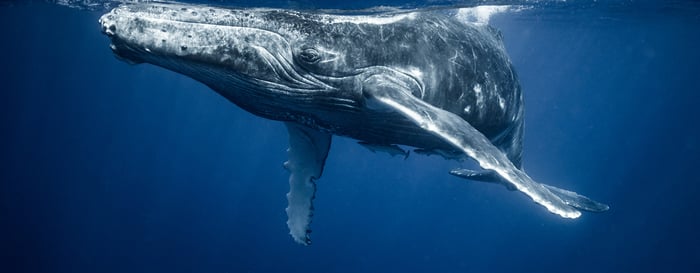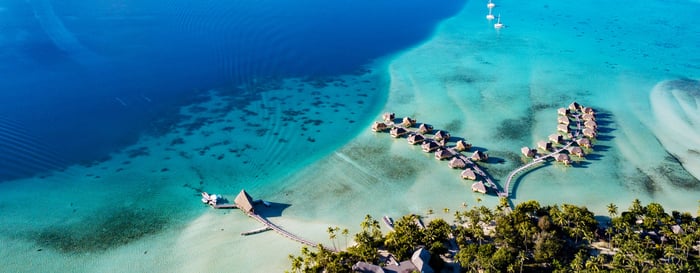Most of us have dreamt of this place, this world of islands. It exists out there on the periphery of our collective imaginations – the palm-fringed shores, the turquoise seas, the pristine beaches, the happy islanders, the swaying grass skirts – hovering somewhere between a week in the Seychelles and a lifetime in the Garden of Eden.
I was island hopping in the remoter archipelagos of French Polynesia, travelling on a small cruise ship, marvelling at how much the reality of this island world matched the fantasy. When I came ashore on Mangareva, I was welcomed in much the same way as Captain Bligh of the Bounty, over two centuries ago – drumming and dancing, grass skirts and fresh fruits, smiling faces and floral garlands. This wasn’t a tourist show – Mangareva rarely gets tourists – it was just a welcome party and most of the islanders had turned out for the festivities.
From the earliest voyages of exploration, Europeans returned from the Pacific with breathless tales of an island world that seemed too gorgeous to be credible. Artists and writers were soon drawn to the South Seas in search of this terrestrial paradise. When Robert Louis Stevenson arrived on these treasured islands, he vowed never to leave. When Gauguin discovered Polynesia, he couldn’t stay away, filling his paintings with their rich colours and sensual forms.

It was in the 19th century, that the French laid creeping claim to a great swathe of Polynesia – some 118 islands spread across 2000 kilometres of ocean – first as a French protectorate and later an autonomous territory. The French presence adds a curious gloss of sophistication to many remote innocent islands. On Mangareva, barely five-miles long, I strolled along a coast road, flanked by mango and breadfruit trees heavy with fruit, past the French gendarmerie flying a tricolour and a café selling excellent croissants, to the Catholic church built by the French missionary, Pere Laval, in 1840’s, its twin spires silhouetted against a steep backdrop of tropical greenery. Inside was an altar made entirely of mother of pearl.
From Mangareva we sailed westward towards Raivavae and Rurutu, small islands of dense vegetation, dramatic peaks and people who seemed to have all the time in the world. At Raivavae, I hiked to the top of Mount Hiro for a stunning vista over vast reaches of ocean. At Rurutu I cycled along shore roads past gaily-painted houses with pretty gardens of flowers and views of turquoise seas. I trekked through the undergrowth to visit the marae, the ruins of the ceremonial centre of these islands where archaeologists found the exquisite sandalwood figure of Taaroa, a creation god now in the British Museum. Then I set off in an outrigger canoe for a lagoon beach where I spent the day gravitating between dozing in a hammock and snorkelling on coral gardens while a party of islanders drummed and danced on the shore.
When we dropped anchor a few days later in the lagoon of Bora Bora, it seemed a world away from these more remote islands. Resorts and luxury beach hotels, shops and restaurants were a sudden intrusion into my Pacific idyll. But you can forgive Bora Bora anything. The atoll is ravishingly beautiful, and you can't complain about excellent restaurants. We followed an inland road to the island’s highest point where American GI’s installed anti-aircraft guns during the War in the Pacific. Far below, framed by palm trees, anchored yachts were slivers of silver in the lagoon’s evening light.

Bora Bora was home to Tarita, Marlon Brando’s love interest on the film of Mutiny of the Bounty. When Brando arrived in Tahiti to film Mutiny on the Bounty, he was smitten, with the islands of French Polynesia, as well as with his co-star. He would marry Tarita, in August of 1962 as the film was premiering in London, and two years later, he bought Tetiaroa, an atoll that had once been the reserve of Tahitian royalty, just over 30 miles to the north of Tahiti. It was, he said, ‘more gorgeous than anything I anticipated.’ The marriage lasted 10 years, making it one of Brando’s longest relationships. The atoll was a lifetime’s passion.
It is more gorgeous than I anticipated too, and I had just crossed the Pacific, visiting a dozen dreamy islands on the way. Like Brando himself, Tetiaroa is a one-off. Some five miles wide, it contains 13 tropical islands, some barely larger than a sandbank, others palm-clad paradises a few miles long. Protected by a coral reef, it feels like an enclosed world, some a place apart, a parallel universe, somewhere where the usual rules and conditions may not apply. For centuries the atoll was a royal retreat for Tahiti chiefs. It is now a nature reserve where turtles nest on empty beaches, sea birds stalk the shallows, clouds come and go like phantom ships. Brando adored it, and so did I.
Since Brando’s death, the family have created a luxury resort – simply named the Brando – on one of the islands. This is the place for which the phrase ‘barefoot luxury’ was coined. Spacious villas are hidden among the palm trees, all elegant spaces and floor to ceiling windows, and each with a secluded beach front and a private plunge pool. Guests cycle along the sandy paths, latticed with palm shadows, to the discreet central complex where an elevated bar overlooks the ocean and a French and a Japanese restaurant offer the best food in the Pacific. Should you wish to, there are no end of excursions around the atoll.
But perhaps you are like me. You have reached the place that so many have claimed as paradise. It is probably enough to lie in a hammock, listening to the soft rattle of the palm trees and the slow sound of the surf, dreaming the day away.
Family Break in French Polynesia
- Sail around French Polynesia’s famous ‘motus’ while learning about marine life and searching for stingrays
- Enjoy traditional Tahitian food such as Tahitan raw fish and meat skewers
- Go quad biking through the lush rainforest at Opunohu’s bay
- Snorkel around Bora Bora lagoon’s beautiful coral gardens
- Relax on pristine sands and soak up the region’s extraordinary mana
Luxury Island Hopping in French Polynesia
- Witness French Polynesia from a Cessna 208 Caravan amphibian
- Go on a cultural tour of Taputapuatea and learn about local life with a private guide
- Experience the mythical lagoon of Bora Bora from a floating lounge
- Take a scenic flight over Bora Bora and the heart shaped atoll of Tupai
- Rejuvenate at The Brando, Marlon Brando’s private atoll which is now a stunning beach resort







